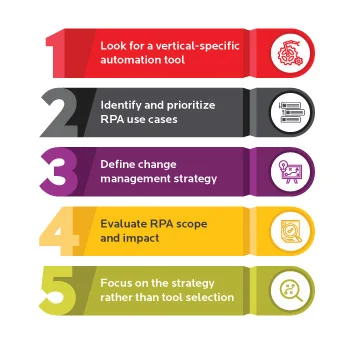The current state of the insurance industry makes it imperative to adopt the latest digital innovations, such as robotic process automation (RPA) and artificial intelligence (AI). Together, this will enable intelligent automation where machines can adapt to insurance workflows as per customer demand and expectations nimbly. Consider the following statistics to understand this further:
- 49% of customers rank a superior claims process as their number one demand, compared to 42% who prioritize the price point of an insurance product. This means that insurers must adopt RPA to streamline claims processing, above all else.
- Insurance customers want to interact with knowledgeable salespeople when buying a policy, yet this factor sits low on most insurers' priority list. An RPA platform can enable a single source of truth that allows salespeople to offer value-added services; an automated AI chatbot could even deliver knowledge to customers without human intervention.
- 76% of insurers feel they are ready to meet customer expectations of the future – but most firms are lagging in terms of digital maturity. 61% are still in the early stages of transformation, with 17% heavily dependent on manual processes and old systems like spreadsheets and fax. RPA adoption could bridge this gap.
- 89% of insurance agents do not have live chat capabilities, despite customers moving to chat-based interactions en masse. Strategic deployment of automation will be critical to help agents to keep up with customer needs.
These are among the key trends pushing insurers to explore intelligent automation. This reason is why banks, financial service providers, and insurers account for the largest share of the intelligent automation market, a space expected to cross $20.7 billion by 2026. To take advantage of this trend, insurers must keep five factors in mind.

Look for a vertical-specific automation tool
Given the size of the RPA and AI landscape, there are a plethora of options to evaluate. Insurers should be careful to zero in on a solution attuned to their needs – cumbersome document-based workflows, legal regulations, data privacy laws, large volumes of information (structured, unstructured, and legacy formats), etc. Vertical-specific automation will simplify deployment and speed up time-to-value, as there are fewer configuration needs, and the solution fits into the existing IT ecosystem seamlessly.
Identify and prioritize RPA use cases
Initial assessment of business processes will reveal multiple candidates for automation. It is essential to prioritize these use cases according to three parameters
The risk factor, i.e., the risk of business interruption due to the implementation process
The full-time effort (FTE) currently devoted to a task, specifically manual hours
The business value of the use case, be it a superior CX or a direct revenue uptick
Those use cases with a low-risk factor consuming sizeable FTE, and having a tangible business value should be at the top of the automation checklist. Check out this article to understand typical challenges you’ll get into and what it takes to over come them.




